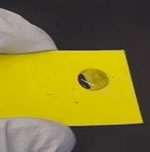
Scientists have invented a super-slippery material inspired by the carnivorous pitcher plants:
... a new material takes a cue from one of the plant world's few meat-eaters: the carnivorous pitcher plant Nepenthes. The plants prey on insects, whose oily feet normally allow them to walk up walls. But pitchers' tube-shaped leaves have microscopic bumps that hold a thin layer of water in place. The water repels the oils, sending hapless insects slipping straight into their gaping mouths.
"They just step on the rim, and immediately slide into the digestive juices," Aizenberg says.
Aizenberg realized that with the right choice of lubricating liquid, the pitcher plant's strategy could be adapted to repel virtually anything.
The researchers started with a textured substrate, which could be almost anything that is rough on the nanoscale, Aizenberg says. One good choice is Teflon, a fibrous material that is widely thought to be super-slippery itself.
Their most slippery surface resulted when they added a layer of the perfluorinated fluid 3M Fluorinert FC-70, manufactured by the firm 3M, to Teflon. The liquid oozed into all the pores in the Teflon, and left a nanometres-thin layer of liquid at the top. The material still feels dry to the touch, and other liquids simply hydroplane off the surface, like a car sliding off a wet road. The team calls the material 'slippery liquid-infused porous surfaces,' or SLIPS.
"We call it SLIPS, because everything does," Aizenberg says.
NewScientist has the story:
here.
 Scientists have invented a super-slippery material inspired by the carnivorous pitcher plants:
Scientists have invented a super-slippery material inspired by the carnivorous pitcher plants:
No comments:
Post a Comment